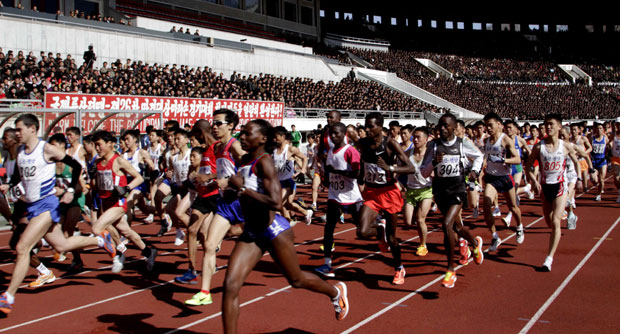Pyongyang opens marathon to tourist-runners

In this April 14, 2013 file photo, runners compete at the start of the 26th Mangyongdae Prize Marathon at Pyongyang’s Kim Il Sung Stadium as North Korea hosts the sports event to mark the birthday of the late leader Kim Il Sung on April 15. For the first time ever, North Korea is opening up the streets of its capital to runner-tourists for the annual Pyongyang marathon, undoubtedly one of the most exotic feathers in any runner’s cap. Tourism companies say they have been inundated by requests to sign up for the April 13, 2014 event, which this year will include amateur runners from around the world. AP
TOKYO — Runners of the world, unite!
For the first time ever, North Korea is opening up the streets of its capital to runner-tourists for the annual Pyongyang marathon, undoubtedly one of the most exotic feathers in any runner’s cap.
Tourism companies say they are getting inundated by requests to sign up for the April 13 event, which this year will include amateur runners from around the world. The race includes a full marathon — with a handful of world-class, invitation-only athletes — a half marathon and a 10-kilometer run.
The opening of the race to recreational runners is in keeping with the North’s ongoing, but sometimes sporadic, effort to earn cash revenue by boosting tourism, usually with well-orchestrated group tours to major arts performances or attractions the North wants to show off.
Earlier this year, North Korea’s government announced a plan to create special trade and tourism zones across the country and unveiled its first luxury ski resort, aimed largely at luring ski enthusiasts from abroad. Under the watch of young leader Kim Jong Un, the North has also been giving sports in general a higher profile. Simple recreational sports facilities, such as outdoor basketball courts and roller skating rinks, have been popping up lately in Pyongyang and some other cities.
Much of North Korea remains off-limits to foreigners, but Pyongyang, with its broad avenues and ubiquitous monuments, is a showcase city and more accessible than other places in the secretive and isolated country.
“I think a lot of the attraction is the ‘Pyongyang’ part rather than the ‘marathon’ part,” said Simon Cockerell, a Beijing-based agent for the Koryo Tours travel agency. “A lot of the people going along to take part are interested in simply doing something a bit unusual, something that would cause a bit of cognitive dissonance in friends of theirs when they tell them they ran a marathon in North Korea.”
Known officially as the Mangyongdae Prize International Marathon, the race is sanctioned as a bronze label event by the International Association of Athletics Federations and has been held annually for 27 years.
The generally flat, full-marathon course entails four loops around the center of the city of 2.5 million.
The race starts at the 70,000-seat Kim Il Sung Stadium and moves on past the Monument to Chinese Soldiers to the Kim Il Sung University area. After that, the runners cross a bridge over the Taedong River to the east side of the city and wind their way along the river bank to the stadium.
Spectators back in the stadium will be treated to soccer games, volleyball and martial arts exhibitions while they wait for the runners to return.
Cockerell said nearly 200 foreigners have signed up for the event, which coincides with commemorations of the April 15 birthday of North Korea’s first leader, Kim Il Sung. That is an unusually large number, though the North’s famous mass games are also often a big draw.
As a practical matter, aspiring runners had to apply through agencies familiar with the North Korean bureaucracy in order to get the proper visas. Cockerell said most are joining packaged group tours to see the sights while they are in Pyongyang.
In the past, the main race has been restricted to a select group of elite runners. Recreational jogging isn’t a part of ordinary North Korean life, but past events have included races for local students and junior runners.
Though many national teams are reluctant to come to North Korea for political reasons, times in the elite part of the race have been up to the international standards. Last year’s marathon was won by Ethiopia’s Ketema Nigusse in 2:13:04. North Korea’s own Kim Mi Gyong won the women’s title for the second straight year, with a personal best of 2:26:32.
What’s new this year is the decision to open up the marathon, half-marathon and 10-kilometer courses to recreational runners of any nationality. The only requirement for marathon runners is that they finish in four hours; those who don’t will be escorted back to the stadium. In 1995, South Korean runners were allowed to participate in a road race in the North, but that was a one-off, Koreans only event. Because of South Korea’s travel restrictions to the North, participation from south of the border this time was unlikely.
“The marathon has traditionally been open only to professional runners with 2:27 male and 2:38 female cutoff times, making it impossible for even the best recreational runner to participate,” said Andrea Uri, head of Uri Tours, an American company offering tours to North Korea. It is bringing 20 runners, most of them American.
“Generally, the country has become more friendly for tourism,” she said. “This change in policy is in line with what we’ve seen to be the tourism administration’s willingness to explore different tour programs and other avenues to attract tourism.”
Cockerell warned against reading too much into the North’s decision to ease its restrictions. It was unclear whether the same rules would apply next year.
“Maybe (it’s) just because they wanted more people in the marathon,” he said. “Maybe the powers that be didn’t expect there to be so many runners entering.”
RELATED STORY